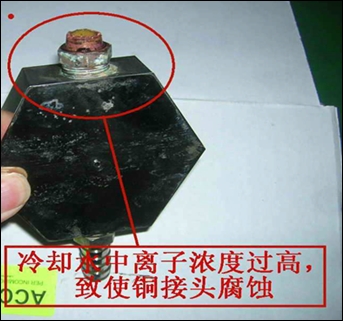- 14
- Apr
Qhov tseem ceeb ntawm cov dej ncig hauv cov hlau ua kom sov
Qhov tseem ceeb ntawm cov dej ncig hauv cov hlau ua kom sov
In most metal smelting furnaces, the furnace body and the power cabinet have two independent water systems, an internal circulation system, an external circulation system, internal closed-circuit deionized water, and include a water-to-water heat exchanger, rectification Silicon, reactors, filter capacitors, inverter silicon, and resonance capacitors are all connected to this system. Since the internal water system circulates in the DC high voltage, the internal cooling water will generate electric ions under the action of the pipeline DC high voltage. After a period of time, the concentration of electric ions will gradually increase. When the concentration of electric ions exceeds the required value, the high DC voltage will corrode the copper joints through the cooling water with high concentration of ions, resulting in the situation seen in the photo below. If the water connector corrodes and breaks during use of the power supply, the pressurized cooling water will spray out, causing major equipment accidents, and the cooling water with high concentration of electric ions will reduce the insulation of the system, which is more likely to cause damage to the thyristor Therefore, the conductivity of the cooling water should be checked regularly, and it must be less than 10us/cm. If the conductivity is greater than 100us/cm, replace the circulating cooling water in all power cabinets, and it is recommended to replace it every six months.

Muaj lwm qhov teeb meem hauv kev siv dej txias kaw uas yuav tsum tau ua tib zoo mloog. Cov dej txias yuav tsum tau nruab nrog lub qhov tso pa. Txawm li cas los xij, hauv kev siv tiag tiag, feem ntau ntawm cov tshuab ua kom dej txias tsis muaj lub qhov tso pa tawm tau teeb tsa. Thaum lub tshuab cua sov tsis ua haujlwm ntev, cov pa tau yooj yim nkag mus rau hauv cov dej sib cais. Thaum cov hlau ua kom sov rov ua dua tshiab, ib feem ntawm cov nkev yuav nyob hauv cov dej sib cais thiab lub thawv dej txias ntawm cov khoom siv thiab tsis tuaj yeem tso tawm, ua rau qhov tsis ua haujlwm ntawm cov khoom no. Kev txias ntawm cov dej sib faib ua rau qhov kub kom txias dhau los hlawv cov khoom. Yog li ntawd, cov dej txias uas tsis muaj lub qhov dej ntws tsis siv ntev, thiab nws tau rov ua haujlwm dua. Cov dej tuav ntawm qhov chaw siab tshaj ntawm cov dej sib cais yuav tsum tau xoob kom ntws cov pa uas seem.
